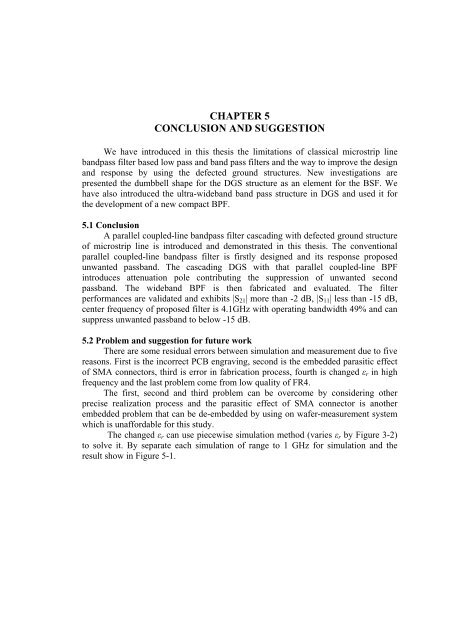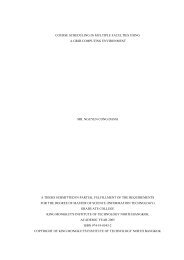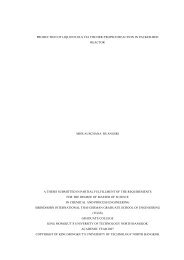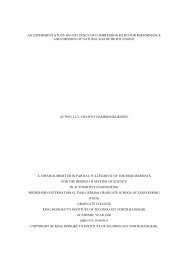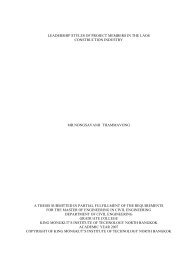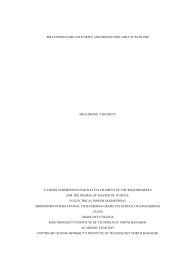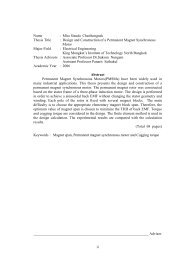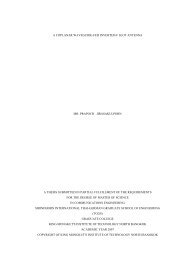a design of the novel coupled-line bandpass filter using defected ...
a design of the novel coupled-line bandpass filter using defected ...
a design of the novel coupled-line bandpass filter using defected ...
You also want an ePaper? Increase the reach of your titles
YUMPU automatically turns print PDFs into web optimized ePapers that Google loves.
CHAPTER 5CONCLUSION AND SUGGESTIONWe have introduced in this <strong>the</strong>sis <strong>the</strong> limitations <strong>of</strong> classical microstrip <strong>line</strong><strong>bandpass</strong> <strong>filter</strong> based low pass and band pass <strong>filter</strong>s and <strong>the</strong> way to improve <strong>the</strong> <strong>design</strong>and response by <strong>using</strong> <strong>the</strong> <strong>defected</strong> ground structures. New investigations arepresented <strong>the</strong> dumbbell shape for <strong>the</strong> DGS structure as an element for <strong>the</strong> BSF. Wehave also introduced <strong>the</strong> ultra-wideband band pass structure in DGS and used it for<strong>the</strong> development <strong>of</strong> a new compact BPF.5.1 ConclusionA parallel <strong>coupled</strong>-<strong>line</strong> <strong>bandpass</strong> <strong>filter</strong> cascading with <strong>defected</strong> ground structure<strong>of</strong> microstrip <strong>line</strong> is introduced and demonstrated in this <strong>the</strong>sis. The conventionalparallel <strong>coupled</strong>-<strong>line</strong> <strong>bandpass</strong> <strong>filter</strong> is firstly <strong>design</strong>ed and its response proposedunwanted passband. The cascading DGS with that parallel <strong>coupled</strong>-<strong>line</strong> BPFintroduces attenuation pole contributing <strong>the</strong> suppression <strong>of</strong> unwanted secondpassband. The wideband BPF is <strong>the</strong>n fabricated and evaluated. The <strong>filter</strong>performances are validated and exhibits |S 21 | more than -2 dB, |S 11 | less than -15 dB,center frequency <strong>of</strong> proposed <strong>filter</strong> is 4.1GHz with operating bandwidth 49% and cansuppress unwanted passband to below -15 dB.5.2 Problem and suggestion for future workThere are some residual errors between simulation and measurement due to fivereasons. First is <strong>the</strong> incorrect PCB engraving, second is <strong>the</strong> embedded parasitic effect<strong>of</strong> SMA connectors, third is error in fabrication process, fourth is changed ε r in highfrequency and <strong>the</strong> last problem come from low quality <strong>of</strong> FR4.The first, second and third problem can be overcome by considering o<strong>the</strong>rprecise realization process and <strong>the</strong> parasitic effect <strong>of</strong> SMA connector is ano<strong>the</strong>rembedded problem that can be de-embedded by <strong>using</strong> on wafer-measurement systemwhich is unaffordable for this study.The changed ε r can use piecewise simulation method (varies ε r by Figure 3-2)to solve it. By separate each simulation <strong>of</strong> range to 1 GHz for simulation and <strong>the</strong>result show in Figure 5-1.


